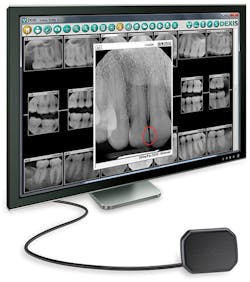Adoption of Digital X-ray: Apprehension Replaced by Appreciation
By Linda Zdanowicz, CDA
The first intra-oral digital sensor was introduced in Europe in 1987, bringing with it many advantages over film, but also a certain amount of apprehension on the part of dental team members. Most dental personnel were completely comfortable taking film radiographs and might even feel they could take a full mouth series in their sleep. No one likes anyone to mess with anything in which they feel very proficient.
Look at it from the assistant’s or hygienist’s point of view. Film is what they know. They could bend the edges a little so that patients felt less discomfort, and they could zip out 18 films in no time. Some remember the old days when they would disappear into the darkroom, deftly dismantle the X-ray packets, tossing the lead foil into the recycling box, and clipping the films onto the hangers in record time. After about 15 minutes of dipping the hangers into the developer, rinse water, and fixer, you had your X-rays ready for the doctor to read.
Consider reading:9 practice management tips from dental industry experts
Consider reading:The advent of electronic dental records
There was a certain amount of satisfaction in being fast and accurate, but there was also a lot of room for error, and re-takes meant another 15 minutes before you had the new film ready to present to the doctor. So, there was a certain amount of stress involved, but it was familiar stress and that made it feel normal.
Automatic film developers made things somewhat faster and maybe a little easier, but these added their own hiccups and kinks. Anyone who used an automatic processor remembers standing and tapping their toes while they waited for a film to re-emerge only to realize it had gotten stuck somewhere along the way. This necessitated fumbling around in the dark and feeling through the rollers to try to find the errant film. Also, think about the reaction to the announcement that it was time to clean the processor, or empty and refill the tanks. Suddenly everyone had to be anywhere but in the darkroom. It was a job very few happily volunteered for.
So, why would anyone hesitate to embrace the wonderful new technology that is digital radiography? Because it’s different and everyone resists difference and clings to the devil they know. For assistants and hygienists who have been in their profession for 10, 20, or 30 years and have yet to switch, it may seem like a challenge. How am I going to take X-rays with something that won’t bend? Are patients going to tolerate a sensor? How will I work this software? Even worse, will it take longer? How will I ever do this? It’s an understandable knee-jerk reaction inspired by fear of failure and resistance to change. But this does not need to be the case. Think about it — so many of your fellow hygienists and assistants have been successfully using digital radiography for years.
Dental assisting and hygiene schools are now incorporating digital radiography into their programs so that new dental professionals will enter their offices with more confidence when presented with digital X-ray technology. What about those seasoned clinicians who are already working? Where do they get encouragement? This is what your peers have found: As with most new technology, it takes a little training, time, practice, patience — and belief in yourself.
Once apprehension is replaced by proficiency, reluctance to incorporate new technology is replaced by a new appreciation for the ease and efficiency of digital radiography. Even better, your peers can have DEXIS experienced expert clinical training (by dental professionals for dental professionals) and daily use a truly comfortable sensor that’s easier to position and more comfortable for patients. Taking an X-ray with DEXIS software is as simple as hitting “X” on the keyboard, and you have access to tutorials that give step-by-step instructions for sensor care, placement, and software use. This helps get you on the track of “X-ray proficiency” in record time. So, don’t fear the technology; it’s a new and important tool that you can master! Once you do, you’ll be glad you ditched film.
Linda Zdanowicz is both a certified practice administrator and certified dental assistant. She authors the Exceptional Dental Practice Management Blog. Linda has presented at the Holiday Dental Conference and the Florida National Dental Conference, and has received the Journal Award from the ADAA. She lives in Hendersonville, NC and manages the practice of Nigel Morgan, DDS. She can be reached at [email protected].

